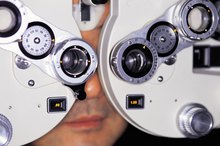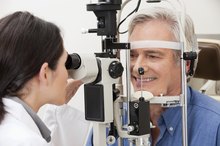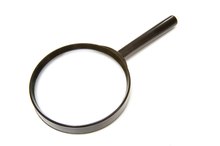Human Eye Shape Types
Human eye shapes can affect vision. There are several different types of eyeball shapes: a normal eye, or one that’s emmetropic; an elongated or myopic eyeball, which causes nearsightedness; and a shortened or hyperopic eyeball, which results in farsightedness. The cornea and lens of the eye can also be shaped differently and affect vision.
Emmetropia
Emmetropia refers to an eye with a cornea and lens that focuses light precisely on the retina. The normal human eyeball measures about 24-25 millimeters in diameter, or approximately 1 inch, according to T. Montgomery, optometric physician. The eye is slightly flattened at the front and back in a roughly spherical shape.
Elongated Eyeball
Nearsighted Vs. Farsighted
Learn More
About 30 percent of people are myopic, which means that their eyeball is longer than normal -- or that their cornea is curved more than normal -- reports the American Optometric Association (AOA) 1. When the light rays fall in front of the eye, the retina makes it easy to see near objects, but difficult to see objects far away. According to the U.S. National Library of Medicine, myopia often begins in the school-age years, with the condition worsening until the early twenties, when the condition stabilizes.
Shortened Eyeball
Hyeropia occurs in people whose eyeballs are shorter than normal, or that have too little curvature to the cornea. Light rays are focused behind the retina, which makes it easy to see faraway objects, but hard to see nearby objects, according to CNN Health.
Astigmatic Eye
How to Identify Eye Grade
Learn More
In astigmatism, the shape and length of the eyeball are normal, but the curvature of the cornea or the lens is abnormal. These structures are normally spherical, but with people who have an astigmatism, the cornea or lens are either football or cylinder shaped. According to the CNN Health website, the curvature produces blurriness which is usually more pronounced in a diagonal, horizontal or vertical direction.
Related Articles
References
- American Optometric Association
- Tedmontgomery.com
- Science Encyclopedia
- American Academy of Ophthalmology. Corneal anatomy, symptoms, and examination.
- Georgia State University. Refraction and the eye.
- Katzman LR, Reiser BJ. Pediatric corneal opacities. American Academy of Ophthalmology. Updated June 21, 2016.
- Sridhar MS. Anatomy of cornea and ocular surface. Indian J Ophthalmol. 2018;66(2):190-194. doi:10.4103/ijo.IJO_646_17
- U.S. National Eye Institute. Corneal conditions. Updated August 3, 2019.
- U.S. National Library of Medicine, MedlinePlus. Corneal disorders. Updated January 8, 2020.
- U.S. National Library of Medicine, MedlinePlus. Fluorescein eye stain. Updated March 4, 2020.
- U.S. National Library of Medicine, MedlinePlus. Cornea. Updated August 28, 2018.
Resources
Writer Bio
A registered nurse with more than 25 years of experience in oncology, labor/delivery, neonatal intensive care, infertility and ophthalmology, Sharon Perkins has also coauthored and edited numerous health books for the Wiley "Dummies" series. Perkins also has extensive experience working in home health with medically fragile pediatric patients.









